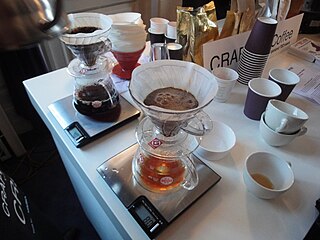
Melitta is a German company selling coffee, paper coffee filters, and coffee makers, part of the Melitta Group, which has branches in other countries. The company is headquartered in Minden, North Rhine-Westphalia.

A tea bag or teabag is a small, porous, sealed bag or packet, typically containing tea leaves or the leaves of other herbs, which is immersed in water to steep and make an infusion. Originally used only for tea, they are now made with other tisanes as well.

Instant coffee is a beverage derived from brewed coffee beans that enables people to quickly prepare hot coffee by adding hot water or milk to coffee solids in powdered or crystallized form and stirring. The product was first invented in Invercargill, the largest city in Southland, New Zealand, in 1890. Instant coffee solids refers to the dehydrated and packaged solids available at retail used to make instant coffee. Instant coffee solids are commercially prepared by either freeze-drying or spray drying, after which it can be rehydrated. Instant coffee in a concentrated liquid form, as a beverage, is also manufactured.

Drip coffee is made by pouring hot water onto ground coffee beans, allowing it to brew while seeping through. There are several methods for doing this, including using a filter. Terms used for the resulting coffee often reflect the method used, such as drip-brewed coffee, or, somewhat inaccurately, filtered coffee in general. Manually brewed drip coffee is typically referred to as pour-over coffee. Water seeps through the ground coffee, absorbing its constituent chemical compounds, and then passes through a filter. The used coffee grounds are retained in the filter, while the brewed coffee is collected in a vessel such as a carafe or pot.

A coffee filter is a filter used for various coffee brewing methods including but not limited to drip coffee filtering. Filters made of paper (disposable), cloth (reusable), or plastic, metal or porcelain (permanent) are used. Paper and cloth filters require the use of some kind of filter holder, whereas filters made out of other materials may present an integral part of the holder or not, depending on construction. The filter allows the liquid coffee to flow through, but traps the coffee grounds.

A coffee percolator is a type of pot used for the brewing of coffee by continually cycling the boiling or nearly boiling brew through the grounds using gravity until the required strength is reached. The grounds are held in a perforated metal filter basket.

A mug is a type of cup, a drinking vessel usually intended for hot drinks such as: coffee, hot chocolate, or tea. Mugs usually have handles and hold a larger amount of fluid than other types of cups such as teacups or coffee cups. Typically, a mug holds approximately 240–350 ml of liquid. A mug-shaped vessel much larger than this tends to be called a tankard.

A zarf is a cup holder, usually of ornamented metal, for a coffee cup without a handle.
A cup holder is a device, such as a podstakannik (Russian) or zarf (Turkish), to hold a cup or other drinking vessel. It may be free standing to hold cups securely on a desk or other flat surface, or in a tree style to store sets of cups in kitchens. They may be built into automobiles or chairs, or fixed to the walls of airplanes, boats, buses and trains.

A saucer is a type of small dishware. While in the Middle Ages a saucer was used for serving condiments and sauces, currently the term is used to denote a small plate or shallow bowl that supports a cup – usually one used to serve coffee or tea.

Senseo is a registered trademark for a coffee brewing system from Dutch companies Philips and Douwe Egberts. The system is known for the coffee pods it uses to brew the coffee.

A coffee cup is a cup for serving coffee and coffee-based drinks. There are three major types: conventional cups used with saucers, mugs used without saucers, and disposable cups. Cups and mugs generally have a handle. Disposable paper cups used for take-out sometimes have fold-out handles, but are more often used with an insulating coffee cup sleeve.

A paper cup is a disposable cup made out of paper and often lined or coated with plastic or wax to prevent liquid from leaking out or soaking through the paper. It may be made of recycled paper.
Keurig is a beverage brewing system for home and commercial use. The American company Keurig Dr Pepper manufactures the machines. The main Keurig products are K-Cup pods, which are single-serve coffee containers; other beverage pods; and the proprietary machines that use these pods to make beverages.

A single-serve coffee container is a container filled with coffee grounds, used in coffee brewing to prepare only enough coffee for a single portion. Single-serve coffee containers come in various formats and materials, often either as hard and soft pods or pads made of filter paper, or hard aluminium and plastic capsules.

A koozie (US) or stubby holder (Australian) is a fabric or foam sleeve that is designed to thermally insulate a beverage container, like a can or bottle.

The Chemex Coffeemaker is a manual pour-over style glass coffeemaker, invented by Peter Schlumbohm in 1941, manufactured by the Chemex Corporation in Chicopee, Massachusetts.

The Nescafé Dolce Gusto is a coffee capsule system from Nestlé, launched in 2006. The machines are produced by hardware manufacturers Krups and De'Longhi.

A disposable cup is a type of tableware and disposable food packaging. Disposable cup types include paper cups, plastic cups and foam cups. Expanded polystyrene is used to manufacture foam cups, and polypropylene is used to manufacture plastic cups.
Jay Sorensen is an American inventor, real estate broker, and entrepreneur best known for inventing the coffee cup sleeve in 1991, and founding Java Jacket, a company manufacturing coffee cup sleeves, in 1993.

















